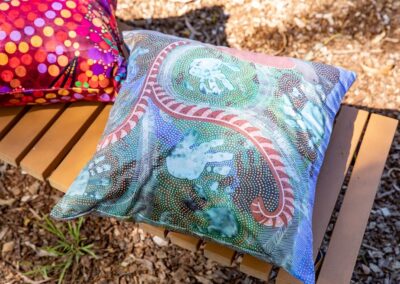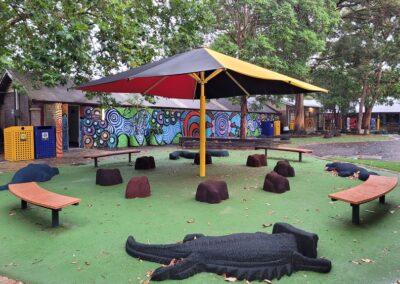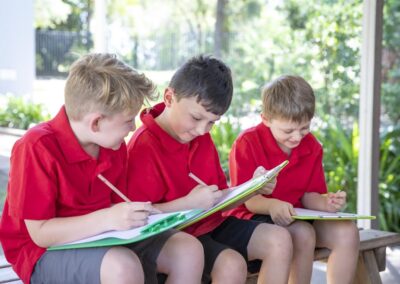LEARNING ACTIVITY
STORY
Jarrah was really keen to start the yarning circle in his school. He found a nice place to sit in an open patch of lovely lush grass underneath an old Kurrajong tree in one section of the playground. Jarrah excitedly gathered his friends together in the area.
Jarrah: “Ok everyone, I have brought you all over here to sit in the yarning circle I have created.”
Ricky:“What’s this all about, bra? We were in the middle of an epic game of footy – last try wins!”
Jarrah: “I want us all to sit in the yarning circle like my ancestors used to do.”
Ricky: “Well ok, and what are we meant to do?”
Jarrah: “Hmmm, actually I don’t know.”
Ricky: “This is silly… We’re off!”
Adam: “Haha, not so fast… I’ve just seen what you fellas are up to! This is great, Jarrah, but maybe you need to speak to some community and Elders first before you launch into making your own yarning circle! You know Aunty Vi is coming to the school next week to do a Welcome and Smoking Ceremony for Reconciliation Week? How about we have a chat to her and her son Paul about setting up a space and ask if they are happy to share some knowledge about yarning circles?”
Jarrah: “That sounds great, I can’t wait!”

This activity is the third activity in an 8-part activity sequence that has been developed to help you design, build and use a yarning circle in your school or community.
This activity will help guide how you might work with your local Aboriginal and/or Torres Strait Islander community as part of your yarning circle project.
The order of these learning activities are: background, site selection, involving First Nations people, building the yarning circle, connecting to Landcare, using the yarning circle, yarning circle activities and yarning and wellbeing.
For children to:
- learn how to develop questions and explore different ways they can be answered
- connect with First Nations people
- involve First Nations people in the project
- consider the opinions of others
- apply learnings to a real-world project.
This activity can be undertaken at any time of the year.
Introduction
It is important to think about how you might work with the local First Nations community. Considerations include:
Try to invite and incorporate First Nations’ voices and opinions from the very start of the project so that it is carried out as respectively and cooperatively as possible throughout.
You can research service providers for gardens and landscaping on websites like Supply Nation, which is a site set up to promote First Nations businesses in many different fields.
Does your school have Aboriginal and Torres Strait Islander students who would like to get involved in the project? They may have an idea about the design. Maybe they would like to design other cultural elements for the yarning circle or incorporate a special animal, plant or artefact that is important to them.
This may also be a good opportunity to incorporate a traditional story of the area where you live, working with the local Custodians and Elders. Keep in mind, their time is precious and you will need to have budget set aside for their time and assistance. If you need to purchase any items, such as a talking stick, to help your yarning circle operate, make sure you let them know early so they have time to prepare or help source materials.
For educators, Landcare facilitators or students starting the community consultation journey who feel they may not know where to begin, our advice is start talking with the Aboriginal and Torres Strait Islander families connected to your school. There may be an Indigenous Learning Officer or similar type of staff member in or connected to your school who could give you advice about working with/connecting with families of Aboriginal and Torres Strait Islander students. If such a role does not exist at your school, then reach out directly to families of/other students. Even if they do not have exact information on how to set up a yarning circle themselves, they may be able to connect you with Elders and/or community members who do have skills and knowledge to help you.
* This will be dependent on drafting and other aspects of the task
Checklist
Instructions

STEP 1
Introduction:
Begin this activity with an Acknowledgement of Country. By acknowledging the Land, you are also making a promise that you will recognise the Cultural practices of First Nations people.
Use the story above to provide background information.
Ask the students: “Why is it important that we work with First Nations people as much as possible for this project?”
Remind them that consulting with your local Elders and First Nations community is essential to building relationships. This is important to do throughout the process of setting up your yarning circle.
Creating a yarning circle is also a good opportunity to invite an Elder to speak at your school or to your group on regular occasions.

STEP 2
Identify learning needs:
You may also like to reach out or find contacts in your local First Nations community. You could speak to parents of First Nations students, speak to the Indigenous Learning Officer at your school and/or your local Land Council or Landcare group.
Alternatively use the interactive AIATSIS Map of Indigenous Australia.
As a group, find out ‘Whose Country am I on?’
Consider engaging a First Nations artist or First Nations business to be part of your project (such as landscapers, garden designers or nurseries, which are great places to source your plants and to help out with knowledge about how to grow and use them).

STEP 3
Investigate opportunities:
As a group, discuss how your project could be improved by working with First Nations people.
There are many elements that you may wish to include, for example:
- Commission a local First Nations artist to work with you to create a Cultural art piece or installation.
- Create an Indigenous plant use garden and work with local Elders to develop signs that include appropriate plant use information.
- Design your yarning circle to include important elements to the local First Nations peoples group.
If you are interested in using an Aboriginal or Torres Strait Islander name or word, story or artwork, it is important to request permission and consult with your local Traditional Owners. Refer to the Educator Notes for more information.

Step 4
Make a project plan:
Compile a list of the different stages of the project.
Discuss how you could involve First Nations people at each stage of the project. Note: all stages of this project have the potential for First Nations involvement, input and participation.
Your students will probably have a lot of questions at this point.
As a group, identify what questions could be answered by First Nations people.
Compile this list and add it to the children’s ideas of how you might involve First Nations groups in your project.
Present this list to School Council/Leadership.
Extension Activity
Language in your area: research First Nations words and their meanings such as ‘welcome’ that you can incorporate into your yarning circle.
Investigate Indigenous plants in your area and make a plan to include these in and around your yarning circle space. If you already have some of these plants growing in the area, investigate how First Nations people use these.
Curriculum and Framework Links
SCIENCE
Year 5: ACSHE083
Year 7: ACSHE120
Year 8: ACSHE135
HUMANITIES AND SOCIAL SCIENCES
Year 2: ACHASSI042
Year 3: ACHASSI052, ACHASSI059, ACHASSI060
Year 4: ACHASSI080, ACHASSK088, ACHASSK090
Year 5: ACHASSI102, ACHASSK120
Year 6: ACHASSI122, ACHASSI130
DESIGN AND TECHNOLOGIES
Year 2: ACTDEK003
Year 3 & 4: ACTDEP017
Year 5 & 6: ACTDEP019
Year 7 & 8: ACTDEK032
HEALTH AND PHYSICAL EDUCATION
Year 2: ACPPS018, ACPPS022, ACPPS023
Year 3 & 4: ACPPS036, ACPPS040, ACPPS041
Year 5 & 6: ACPPS054, ACPPS059
Year 7 & 8: ACPPS073, ACPPS078
ABORIGINAL AND TORRES STRAIT ISLANDER HISTORIES AND CULTURES
ETHICAL UNDERSTANDING
Exploring values, rights and responsibilities.
PERSONAL AND SOCIAL CAPABILITY
CURRICULUM CONNECTIONS
CROSS CURRICULUM PRIORITY
MY TIME, OUR PLACE: FRAMEWORK FOR SCHOOL AGE CARE
Reference List
ONLINE RESOURCES
Explore the Whose Country: exploring First Nations peoples languages map learning activity in the Junior Landcare Learning Centre.
PRINTABLE RESOURCES
Download a Map of First Nations lands
WATCH
Watch First Nations student Zara and her friends discuss the significance of headrests with Junior Landcare ambassador Costa.
Explore the Australian Children’s Television Foundation’s Language of Belonging Teaching Resource designed specifically for Primary-aged students.
READ
Learn about First Nations cultures and experiences via the Australian Museum’s First Nations page.
NETWORK
We recommend reaching out to the Local Traditional owners and First Nations peoples community groups who can assist in knowledge sharing and understanding local land, language, stories and culture.
To reach out or find contacts in your local First Nations community you could speak to parents of First Nations students, to an Indigenous Learning Officer (ILO) at your school or to a local Land council.
We have some suggested organisations to approach listed on our Junior Landcare Community page.
We value your feedback
When you have finished this learning activity, please tell us what you think with our survey.
Your feedback will help Landcare Australia improve the activities in the Junior Landcare Learning Centre.
Why not try one of our other Junior Landcare learning activities?
Creating an Indigenous plant-use garden: plant list
First Nations Perspectives
Creating an Indigenous plant-use garden: resources from the bush
First Nations Perspectives
Love Letters to the Land
Biodiversity|First Nations Perspectives|Food Production|Waste Management
Creating a yarning circle: yarning circle activities
First Nations Perspectives